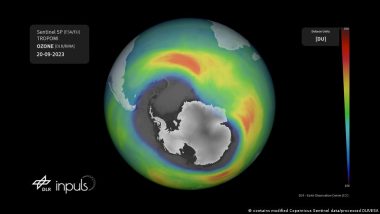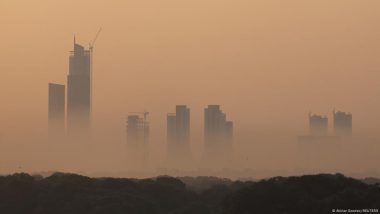The ozone hole over Antarctica is one of the biggest on record, roughly three times the size of Brazil. It's a natural phenomenon, but scientists are concerned climate change could begin reopening ozone holes.Satellite measurements over Antarctica have detected a giant hole in the ozone layer.
Also Read | Cancer Prevention: Would You Want AI to Predict Your Fate?.
The hole, which scientists call an "ozone depleted area" was 26 million square kilometres (10 million square miles) large. This is roughly three times the size of Brazil.
Also Read | Elon Musk Plans For Mars: Unmanned Test Landing Possible on Red Planet in Next Four Years, Says SpaceX CEO.
The European Space Agency (ESA) Copernicus Sentinal-5P satellite made the recordings on September 16, 2023, as part of the EU's environmental monitoring program.
Claus Zehner, ESA's mission manager for Copernicus Sentinal-5P, told DW that this is one of the biggest ozone holes they've ever seen.
"The satellite measured trace gases in the atmosphere in order to monitor the ozone and climate. It showed that this year's ozone hole started earlier than usual, and had a big extension," said Zehner.
Experts believe the hole in the ozone is not likely to increase warming on the surface of Antarctica.
"It's not a concern for climate change," said Zehner.
Ozone holes grow and shrink every year
The ozone layer is a trace gas in the stratosphere, one of the four layers of the earth's atmosphere.
It functions as a protective gas shield that absorbs ultraviolet (UV) radiation, protecting humans and ecosystems from dangerous amounts of UV. Most skin cancers are caused by exposure to high amounts of UV radiation, so anything that shields us from UV rays helps reduce cancer rates.
The size of the ozone hole over Antarctica fluctuates each year, opening each year in August, then closing again in November or December.
Zehner said the ozone hole opens up because of the rotation of the Earth causing specials winds over the closed landmass of Antarctica.
"The winds create a mini climate, creating a shield over Antarctica preventing it from mixing with air surrounding. When the winds die down, the hole closes," he said.
What caused the giant ozone hole this year?
Scientists believe this year's big ozone hole could be due to the volcanic eruptions at Hunga Tongain Tonga during December 2022 and January 2023.
"Under normal conditions, gas released from a volcanic eruption stays below the level of the stratosphere, but this eruption sent a lot of water vapor into the stratosphere," said Zehner.
The water impacted the ozone layer through chemical reactions and changed its heating rate. The water vapor also contained other things that can deplete ozone like bromine and iodine.
"There isn't much evidence the ozone hole is due to humans," Zehner said.
Man-made ozone holes
While this year's Antarctic ozone hole was likely due to a volcanic eruption, scientists became aware that human activities were creating huge ozone holes in the 1970s.
Ground and satellite-based measurements detected the man-made holes, which were caused by widespread use of chemicals called chlorofluorocarbons (CFCs).
"The culprit behind ozone depletion was not aerosols in aerosol cans, but the propellants we use as gases to propel the solutions inside. These gaseous propellants contain chlorine, which is released high in the stratosphere and depletes the ozone," said Jim Harwood, a professor af atmospheric science at Univerisity of Exeter, UK.
The world took action after scientists raised alarm over the ozone holes, and quickly. In 1987,The Montreal Protocol was created to protect the ozone layer by phasing out the production of these harmful substances.
The good news is that the protocol was effective — ozone holes got smaller in the decades after ozone-depleting gas emissions were controlled.
Is climate change reopening ozone holes?
Scientists agree that ozone depletion is not a principal cause of global climate change.
However, Harwood said there are signs that rising global temperatures could be impacting ozone holes.
"Our mitigation of the ozone hole was working well since the 1980s, but in 2020 we were taken by surprise when the 2020 ozone hole was very deep and long lasting," Harwood told DW.
The same was true for 2021. Research showed that the main reason for the large ozone hole in 2020 was due to the wildfires in southeastern Australia that year.
Harwood said that as the climate crisis carries on, with the Earth continuing to warm, fires are getting more common and more devastating around the globe.
"It's been an amazing bad year for boreal fires in the northern hemisphere this year. If that continues to happen, we get more smoke injected into the stratosphere, and we might get more ozone depletion coming back," said Harwood.
It's less clear what impact ozone holes have on the earth's climate. Some data shows that ozone holes actually contribute to cooling effects, as they reduce the greenhouse gas effect.
But Harwood said there is evidence ozone holes changes the progression of the seasons.
"If you get ozone depletion, it takes longer for the hole to repair. This means you have a longer, more drawn out polar vortex, so you'll have wintertime lasting that little bit longer," he said.
Edited by: Carla Bleiker.
(The above story first appeared on LatestLY on Oct 06, 2023 07:50 PM IST. For more news and updates on politics, world, sports, entertainment and lifestyle, log on to our website latestly.com).













 Quickly
Quickly





















